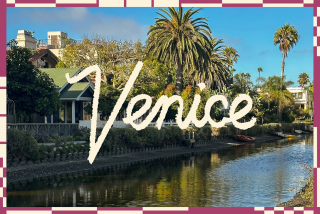Reflections on ‘Venice of the North’
- Share via
AMSTERDAM, Netherlands — A tiny breath of a breeze wafts through this old port city, stirring up ripples that gently dance across the glimmering surface of the canals.
Bricks melt. Windows dissolve. When the wind and sunlight are just right, Amsterdam’s famous waterways can reflect its very soul, a shimmering vision like an Impressionist masterpiece by Monet or a Cubist abstraction by Picasso.
Some days it happens a dozen times and lingers deliciously. Other days it occurs for a fleeting instant or not at all.
And most people don’t even notice.
Not the natives, who stare straight ahead as they pedal their bicycles to work, school or market. Certainly not the tourists, who tend to fix their gazes upward at the ornate houses that line the canals.
But look down and you may catch a glimpse of Amsterdam’s hidden beauty, perhaps the reflection of part of a canal house and a bridge, distorted by gentle waves stirred up by the slightest of winds.
It’s not surprising that Amsterdam’s soul can be found in the canals. They are the very essence of the “Venice of the north,” looping through the city in a horseshoe pattern crosshatched by hundreds of tiny bridges.
Legend has it that in the 12th century a strong gale forced two fishermen to the swampy banks of the Amstel River delta. There they sheltered in the wrecked hull of their boat.
Others followed and made a small settlement, erecting a dam to protect it from the river. They named the new village Amstelledamme--Dam on the Amstel.
The Dutch went on to conquer the sea, building homes where waves once pounded. More than half of today’s Netherlands lies under sea level.
The watery images of the canals, distorted and fleeting, capture the very spirit of Amsterdam: so old and traditional, yet so youthful and liberal.
It is the secret life of the city.
More to Read
Sign up for The Wild
We’ll help you find the best places to hike, bike and run, as well as the perfect silent spots for meditation and yoga.
You may occasionally receive promotional content from the Los Angeles Times.






